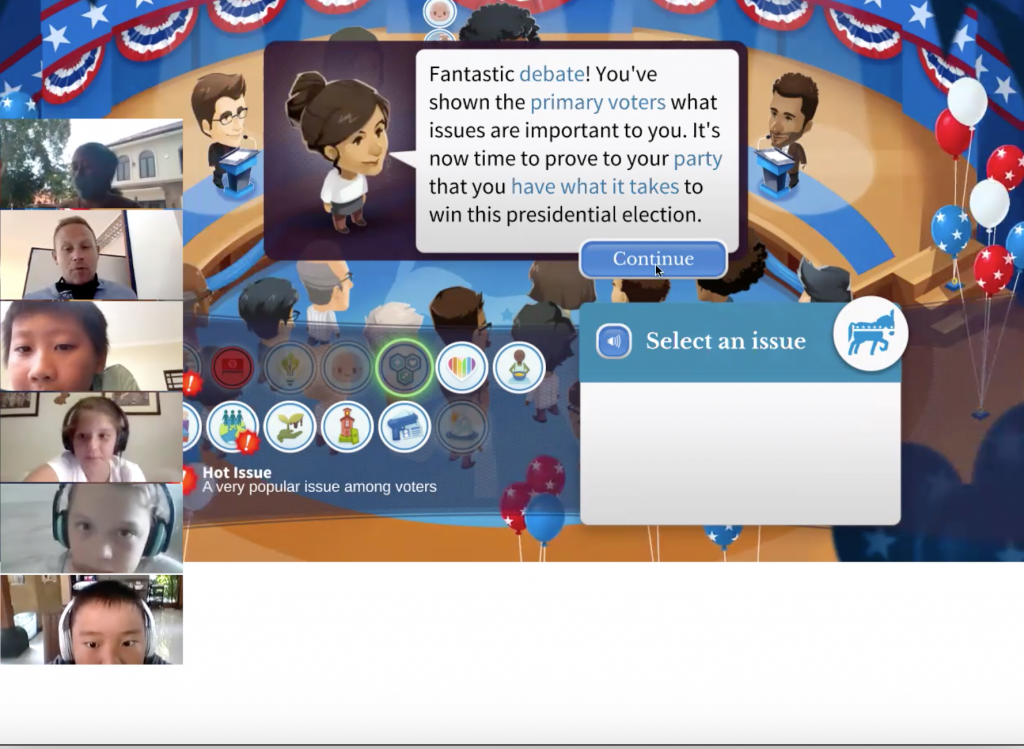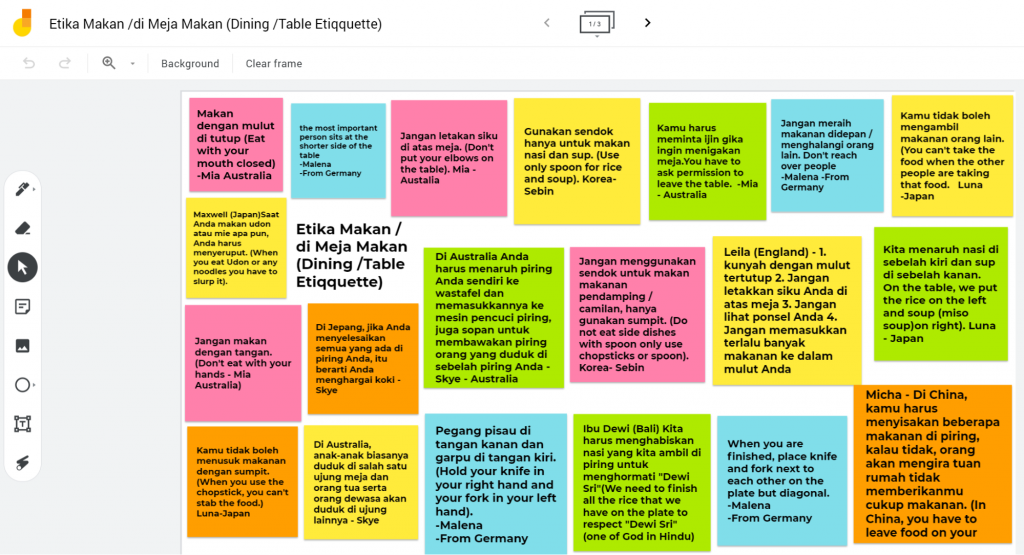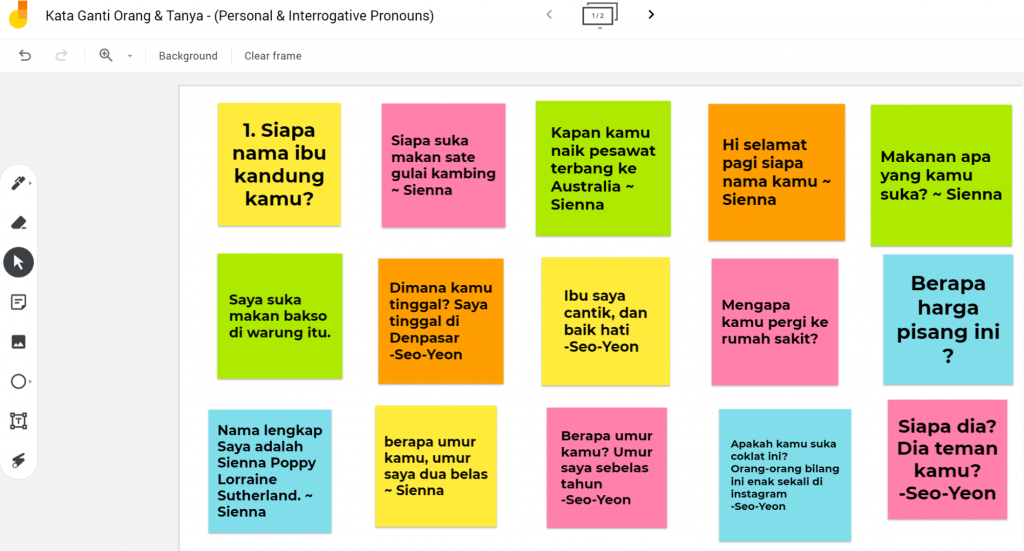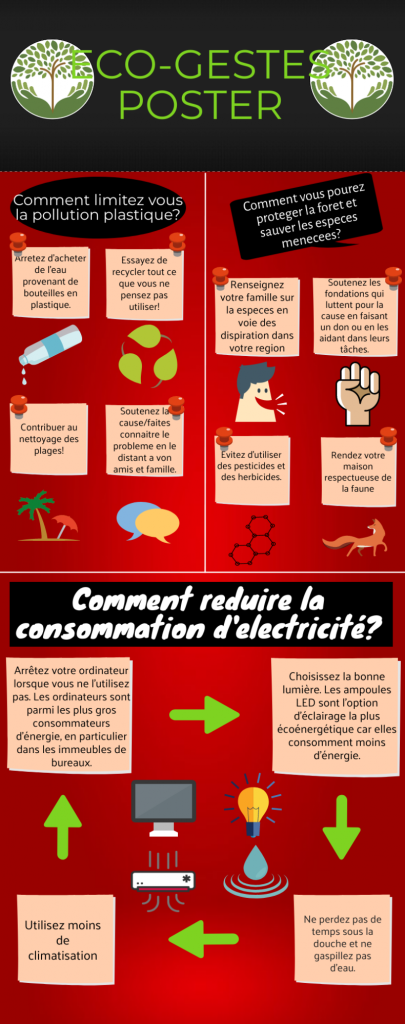Secondary Newsletter 10 – October 23, 2020
Making It Fit
Language Updates
CAS Corner
Counseling
Actor’s Lab Spotlight – Amieca Joustra as PIERROT
Making It Fit

The New York Times, one of the world’s “newspapers of record”, has, since 1896, used the slogan of “All The News That’s Fit To Print”. Fast forwarding to the current moment and relating to distance learning in 2020, that phrase could be modified slightly to “All The Learning That Fits in Class” or something along those lines.
In a “normal” school year, most teachers who have been at a particular school for more than a year have a pretty good idea of what units, lessons and skills they will be teaching and what activities and tasks will be used to deliver that content. This is mapped out over the course of the year and should line up with other related content being taught and can be enhanced by collaborating with other staff such as the librarian or language or support teachers. Of course, there are adjustments made in real-time and there are always unexpected events and the need to adapt throughout the year but these tend to be peripheral and not sweeping, large-scale shifts that drastically change the year-long planning.
Those norms – for now – are out the window. One of my biggest challenges during distance learning (online teaching) is facing the reality that some content and teaching methods that used to translate brilliantly (or be a favorite of teachers and/or students) now resonate and translate differently because the literal increased distance and unavailability of face to face learning renders the learning task either too obtuse, a “lost in translation”-type feel or the lacking in the needed engagement to make it work effectively.
An example of a learning task that now presents itself in a way that is not what was expected when it was previously being planned when it was originally conceived is using a suite of interactive education games via the iCivics website that teaches civics, government operations and history. This website has a plethora of high quality, digestible games but three in particular that are almost perfect when teaching within the Grade 5 Unit of Inquiry “How We Organize Ourselves – Government” (this unit should be familiar with all current Secondary BIS students who learned in Grade 5 here with either Nadia Demolder or Alison Whigton) as well as some other MYP units. In a normal setting, there would be direct interaction between the game choices/path and the students, the teacher and the students (with the teacher as a guide to fill in the “blind spots” of content in the game that requires a clear and quick explanation) and between the students themselves, as they would be grouped into smaller groups to take turns conferencing and ultimately making a choice that the game requires. Additionally, the engaging and aesthetically pleasing landscape of the game (complete with humor and drama) is tailor-made for classroom use and a whole-class exchange of ideas, strategies and new knowledge.

In a distance learning setting, this dynamic can change dramatically. Besides having to use online video conferencing software as a conduit to allow students to view the actual content (which can have literal severe lags), the fast feedback and response to what is happening slows down and get muddled. Student interaction is usually changed to individual responses instead of group conferences and thus the risk of boring other students as they wait for their turn to participate increases. Other challenges include receiving audio content accurately (due to the invisible boundaries of receiving instruction digitally), interruptions and distractions and less time for the fun stuff as directions and explanations are usually required to be longer or repeated. The loss of exciting, palpable energy that manifests itself into motivation to stay engaged, try hard and ultimately “win” can also dissolve into the ether in online learning.
There are ways to rectify some of these issues. Instances like iCivics allow for students to practice being independent and navigating the game tasks on their own, at their own pace (this can still be a challenge for students who are still learning English and/or who have inferior tech hardware and internet connectivity) and achieve an authentic sense of accomplishment. The game can still be played with the individual student replacing the whole class. Students are also given more responsibility and trust to complete these tasks on their own, which can speed up maturity and resiliency for future endeavors. Students and teachers could also be proactive and schedule times to play the game in smaller groups together. This could also force students to become more adept at following directions independently (though this could also work adversely by making tasks that much harder for students who require support when starting a learning activity).
Teachers can try to blunt some of these negative effects by using different delivery methods for the content, such as pre-recorded directions. These directions, combined with effective and easy to use screen-casting software that allows students to see both the teacher and the content on the screen simultaneously, can offer students who learn in a variety of ways quality options of understanding the task which they may have to do more independently than previously planned; plus, they can re-watch and pause these directions as much as they need, which is an advantage not available in traditional in-person settings. Classes can then come back together after everyone has played the game independently (or done the task) and compare notes, give feedback and even swap recordings of each other’s experiences.
Teachers can also collaborate with other teachers to co-teach different parts of the lessons to keep students engaged or to avoid repetition. Collaboration can expose new perspectives, fresh ideas and troubleshooting on familiar issues that other teachers may have experienced previously.
Whatever the way that delivery instruction and receiving learning can “fit” into these new digital puzzle pieces, the one constant is the effort and strive for quality by those of us in charge won’t be left on the cutting room floor.
Language Updates
Grade 7&8 Language Acquisition – Indonesian
Grade 7&8 Indonesian Language Acquisition students have been learning about Food and Drink. They were doing research about Typical Spices in Indonesia and gaining knowledge about dining/table etiquette and put all of the information in the Jamboard and Padlet.


Grade 6 Language Acquisition – Indonesian
In Bahasa Indonesia class, Grade 6 students have been learning about Introduction and worked on grammar which is about Personal and Interrogative pronouns. After we had this discussion, they made simple sentences by using the Personal and Interrogative pronouns.

Grade 11 Language Acquisition Ab Spanish
Grade 11 students have been learning the themes of identities, focusing specifically on the prescribed topics of personal attributes and personal relationships. They made interesting presentations about their families. These are some examples of the work they have produced:
Grades 6 & 7 EAL
Grade 6 EAL students have been working on developing their reading and writing skills. Students have learned how to add relevant details when extending sentences. They have improved their accuracy of language through reading and writing short stories. These are some examples of the books they have been reading and their recommendations:
Grade 12 Language Acquisition
Grade 12 has been studying the theme of social organization by looking at the prescribed topics of daily routine, house/home, school and work. Students have been working on their confidence and fluency by developing techniques to give extended answers to questions drawing on all topics and the vocabulary we have studied so far. These are some examples of the work they have produced:

MYP French Language Acquisition
In the French, we have been looking at a variety of topics from our routines to the protection of the environment, as well as what is poetry or how to introduce ourselves in French. There is something for every level and the students did some awesome work communicating what they know.
Je suis poète.

Discussion – aller en ville

Comment protéger l’environnement?

La nourriture de mon pays d’origine.

CAS Corner
Grade 11 students have started their CAS journeys. Even from home, they are engaging in experiences that relate to Creativity, Activity, and Service:
Creativity – Exploring and extending ideas leading to an original or interpretive product or performance.
Activity – Physical exertion contributing to a healthy lifestyle.
Service – Collaborative and reciprocal engagement with the community in response to an authentic need.
CAS is designed to allow students to demonstrate attributes of the IB learner profile in real-life situations. It allows them to explore their interests, expand their passions, and develop into a well-rounded member of society.
Weekly, they will be sharing one of their reflections with the whole community. I hope you enjoy reading about their experiences and learning.
Daily Swimming by Adi Llamas
For my health goal, I decided to partake in daily swimming training at a local pool. A personal goal in regards to swimming, which I highly want to achieve within the past few months of training is improving my swimming race times. This would allow me to be at my competitive potential when it comes to competing. This goal would allow me to work on my determination and ability to commit. As I would be challenged by showing up to training daily and giving my best efforts consistently, I decided to work towards the learning outcome of perseverance and commitment. Another learning outcome I would be working towards would be strength and growth, as physically I would be strengthening my skills and mindset towards the sport. Growth will also be achieved as with intensive swim training, balancing schoolwork, a social life, and family will be severely challenging. This challenge of balancing and managing my time efficiently will give me an opportunity to grow as an individual.

Counseling
Stress is a word that is often overused and misunderstood. MYP students have been exploring the idea of stress at the end of a unit on healthy relationships and communication techniques. Watch this TedTalk (14:28) by Kelly McGonigal, where she discusses the health benefits of reframing our views of stress and explains how oxytocin released during stressful situations leads to seeking connections.
University Counseling
Registrations and deadlines:
Upcoming International SAT Test Date & Deadline

Many universities in the US are moving away from SATs, and not only due to COVID. If G12 students explore US universities and see that testing is optional, this means the university no longer weighs testing as necessary. If students take the SAT and score at the top, it could be helpful as a further indicator of achievement. Universities recognize that grades, especially DP grades, better reflect university success than a one-off test.
Virtual Fairs
BridgeU and BISC Fair – Oct 23 – 28
BridgeU is working with the British International School of Cairo to offer a university fair from October 23 – 28. If you click on the link below you will see that there are different workshops offered on different days. This is a good follow-up to our BIS University Fair because students now have a better idea of the schools, regional requirements and process in general. Please take a look at each day and register for the sessions that suit you. Notice that the Netherlands, for instance, offers more than one session but on different focus areas with different universities presenting.
Please take advantage of attending this fair. The timings vary, so make sure you use the time converter provided.
The British International University Fair – Oct. 28th
Meet 20+ Dutch universities at Virtually Orange! – Nov. 8th
Virtual events
Schools are offering virtual visits to their campuses. As they contact us, we share it with you. If your family is interested in specific schools, you can also look at the websites via Bridge U.
TMC Academy, Singapore
Destination New York Virtual Event
Exciting Opportunity at DePauw University
Scholarships Available at Ohio Wesleyan University
St. George’s University (SGU) School of Medicine
Updates from Trinity College Dublin
Wheaton College online interviews and visits
Virtual Nottingham Event
Bryn Mawr virtual visits
Rutgers University New Brunswick virtual visits
Arts University Bournemouth virtual open days
Resources
UCAS Application Support
List of scholarships for international students
Opportunity for a scholarship from Seton Hall University by sharing a unique business idea
Guide for International University Admissions
BridgeU Supporting your child through the application process (G12 should have shortlists completed and should be moving from shortlists to applications.)
BridgeU tips for parents of 2021
BridgeU tips for parents of 2022
ACTOR’S LAB Spotlight – Amieca Joustra as PIERROT
Enjoy this fantastic original performance and character demonstration from the World of Commedia dell’Arte (grade 10).
Behind the mask of the MASK – Pierrot.
 Also called “Pedrolino” in earlier times, Pierrot is known for being a comedic sad clown. He is known for being an athletic character, using acrobatics to move around and also randomly miming to express himself. His big trait of sadness comes from his tragic love backstory with the character Columbine or Columbina, his long love interest that had rejected him for Arlecchino. His character has influenced a lot of characters in other forms of theatre such as pantomime. Today, we can see a lot of his characteristics in modern everyday characters that gives comedic moments from the characters misery.
Also called “Pedrolino” in earlier times, Pierrot is known for being a comedic sad clown. He is known for being an athletic character, using acrobatics to move around and also randomly miming to express himself. His big trait of sadness comes from his tragic love backstory with the character Columbine or Columbina, his long love interest that had rejected him for Arlecchino. His character has influenced a lot of characters in other forms of theatre such as pantomime. Today, we can see a lot of his characteristics in modern everyday characters that gives comedic moments from the characters misery.
Amieca recounts her experience with creating and presenting the character:
“Finding out why Pierrot is the way he is really gave me insight to how to balance the sadness of his feelings while still maintaining childlike and humorous features.
I was intimidated at first to embody such a round character like Pierrot. But, my decision of really masking up and dressing as Pierrot helped me really get into character. The face make up really helped me explore his facial expressions and convey the sadness in him. As for the plot, I really wanted to convey his self-doubt as he tries to win Columbina over but continues to get rejected. A lot of his expressions come from his face and his acrobatic movements. Focusing on the movements and facial expressions, I let the plot set off in a more improvised way.
I really enjoyed exploring the world of Commedia Dell’Arte and really hope to explore more of it in the future”.











